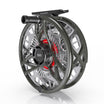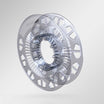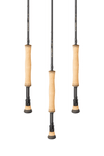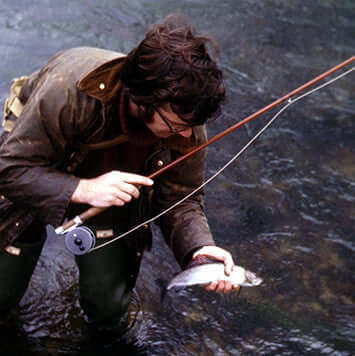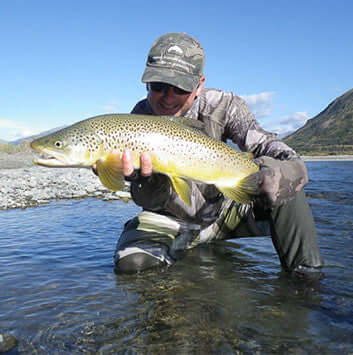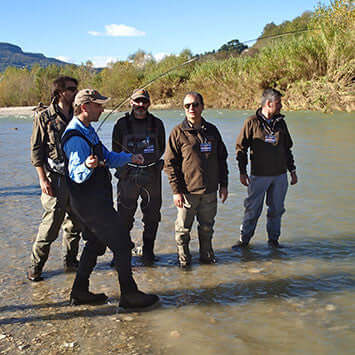My first attempts at fly fishing were as a teenager in the early 1960s. I started with a white, solid fiberglass rod that weighed a ton & a level Kingfisher silk line. Traditional wet flies such as the Teal Blue & Silver, Mallard & Claret & Peter Ross were all that I knew about & fished with for a couple of years. I had very limited success fishing the small Lake District Becks & tiny feeder streams of Lancashire’s River Wyre.
Fortunately in 1966 I bought copies of Eric Horsfall Turner’s Angler’s Cavalcade (1966 edition) & W. H. Lawrie’s Practical Angling Hints & Recipes (1959 edition). These plus the writings of Richard Walker, Frank Sawyer & Oliver Kite opened my eyes to North Country Spiders, nymphs & dry flies. In 1967 I bought a secondhand split cane fly rod & thought it was the absolute ‘tops’, a 10’, very soggy wet fly rod made by E. Kerry of Lockton near Pickering (close to where I now fish). I was at last catching an occasional small trout & even chub with my less than adept skills. 1968 marked a significant milestone, I built a 7’, 4/5 weight hollow fiberglass rod from a Hardy Fibatube blank & bought a new-fangled Scientific Anglers Air Cel, 4 weight, double taper line (Scientific Anglers were the first to produce plastic coated lines in 1952 & the Air Cell plastic lines that incorporated microballoons, to increase buoyancy, in 1954).
I’d also bought a BSA Bantam motorbike & since I was studying Biology at York University I had access to the Yorkshire Rye & some excellent day ticket fishing for trout & grayling. My fly choice had expanded. My early season cast usually had an orange or pink leaded Shrimp on the point (thanks to an article by Richard Walker who said shrimp feeders had pink flesh, which I saw as orange), a Sawyer Pheasant Tail nymph on the middle dropper & a Partridge & orange Spider on the top dropper. As the season warmed up & fish stared to rise it would be a Sawyer nymph on the point, Partridge & Orange or Snipe & purple on the middle dropper & a dry Greenwell’s Glory on the top dropper. Only if there were a good number of risers would I target individual fish with a dry fly. At least now I was catching a reasonable number of fish.

The author & a river Rye grayling (1969)
In 1970 I moved to Hertfordshire to work for the Ministry of Agriculture Fisheries & Food. I still managed an occasional visit up to the Yorkshire Rye & Driffield Canal, but what little fly fishing I did was on the big Reservoirs of the Midlands & Essex for which I built a powerful 9’ fly rod from a fiberglass coarse fishing Avon Rod blank which was teamed up with an 8 weight shooting head & flattened, tapeworm nylon backing, whacking out lures such as Walker’s Sweeney Todd & the Whiskey Fly. Then in 1971 some friends & I cleaned out an old cress bed on the River Lee & stocked it with brown trout & rainbows. The old 10’ cane rod came out of retirement to reach over the marginal reeds.
Buzzers fished under a dry fly proved to be one of the most successful methods, but I had a chance to try out all sorts of flies including, in April, black Tadpoles after I saw a decent brown trout feeding on well developed frog tadpoles which prompted me to head home & tie up some imitations from black chenille & marabou. Soon after moving back to Yorkshire in 1974 I was smitten by the rock climbing, ice climbing & mountaineering bug & I stopped fishing until in 1998 a mountain bike accident temporarily stopped me doing silly things, prompting me to dig out my old fishing gear from the loft. Unbeknown to me my mountain bike buddy, Steve Donohue, was also a flyfisherman & he invited me to fish as his guest on a local still water. First trip out with the old 7’ Fibatube rod & 28 year old Air Cel line & I was hooked again having caught a couple of decent rainbow trout. In 1999 I joined the Derwent Anglers Club as a probationer, fishing the tiny, overgrown Upper Water. I avidly read the informative articles of Oliver Edwards, Stuart Crofts & Malcolm Greenhalgh (plus others), in order to get back to speed & pick up on the latest innovations. Bead-head nymphs, CdC flies & fast actioned carbon fibre rods were the main ones that I picked up on. I soon settled back into the casting & catching & in 2000 invested in a multi-piece carbon fibre 4 weight rod that accompanied me on a 2000 mile cycle tour of the Yukon & Alaska where I caught good numbers of rainbow trout, dolly varden char & grayling, plus an isolated, small, lake trout on both nymphs & dry flies.

Brushkana Creek Alaska
In 2002 I came to the conclusion that my 4 & 5 weight lines were spooking far to many fish when the rivers were low & clear so invested in an 8’ Orvis 1 weight rod that certainly appeared to improve my catch rate. However, my casting still had some way to go before it became anywhere near proficient & I finally teamed the 1 weight rod with a 2 weight silk line in my attempt to improve my fly presentation. (Nowadays, thanks to the dynamics of the Italian Style of casting I happily fish with this rod, a 1 weight line & a 16’ leader or even a Micro Nymph line & 12’ leader set up).
Tenkara
Over the following years I have become besotted by a search for ‘perfect presentation’. This has lead me to using long rods (particularly Tenkara thanks to my friend Robin Goldthorpe who in 2010, asked me what I knew about Tenkara & the excellent Tenkara USA website that showed me the presentational possibilities that this Japanese Style offered), long leaders (usually 15 to 18’ for which I can thank Andrew Ryan at Clonanav in Eire when I visited in 2003) and light lines, 1 weight, 2 weight & 3 weight delicate presentation lines, micro-nymph lines, French leaders & 0.285mm diameter fluorocarbon Tenkara lines. In 2014, in order to effectively cast such light lines I learned the Italian Style of casting that generates high line speed & very tight loops.
This style requires at least 1 line weight lighter than the rod is designed for & long leaders (5m or 16’). It confers several distinct advantages over conventional UK styles since it not only generates higher line speed & tighter loops, facilitating the use of lighter lines & longer leaders, but with most of its armoury of casts it also aims at landing the fly first (as does Tenkara). This confers two advantages; firstly it delays drag since drag can only start to set in once the leader & line have landed & secondly the first thing that the fish sense hitting the water is the fly (food) & not the line (which has the potential to scare).
I am still trying to refine my presentation and fly fishing skills & probably will be doing so till the day that I am too old & decrepit to fish. Progress is generally an accumulation of minor improvements with the occasional bigger step like discovering Tenkara & the development of super thin lines by Sunray.

Massimo Magliocco, Italian Style Casting Guru
Then of course there are the flies. In the 1960s my dry flies had collar hackles tied with poor quality cock hackles (no genetic cock hackles!) & there was far less use of synthetics (just some synthetic yarn & synthetic raffia for shrimp backs). One thing that might surprise a few folks & that is the fact that we had, as mentioned earlier, pink shrimps thanks to Dick Walker & I still have a weighted Peeping Caddis (Stick Fly) given to me by my friend Pete Lancaster in the mid 1960s.
Fly tying innovation
The big advances in fly design for me have been Tungsten Beads, particularly when combined with Jig Hooks, the Paraloop Style of Hackling that allows the fly to sit flush with the surface film (ideal for spent spinner patterns), CdC which has revolutionized my dry flies (my most used dry flies are small Shuttlecocks, Jack Tucker’s IOBO Humpy & its simplified smaller version the Minimalistic Micro-Midge, plus Marjan Fratnik’s F Fly) & the use of
Translucent Materials like Flexifloss, Squirmy Worm material & Catgut. Probably most significant is the development of Barbless Hooks, much kinder to fish, clothing, landing nets & me! Of course there are many other less significant advances such as coloured wires in a range of diameters, tough shell back material for shrimp backs, Tungsten Bidoz bodies, tough Dyneema threads, quality rotating vices & a load of others to numerous to list.

Pete Lancaster’s 1966 Peeping Caddis (Stick Fly) with lead underbody.
We live in an age when the flyfisher is incredibly lucky to have the most incredible tackle available, plus a host of advanced casting & fishing techniques available.
Unfortunately one sad change that I’ve seen is the insidious decline of many fisheries: fly life has been adversely affected with hatches of upwinged flies virtually non-existent on many waters. Whilst the, once dirty, industrial rivers such as the Sheffield Don, have improved dramatically & now provide first class trout & grayling fishing. Most rivers, including my local East & North-East Yorkshire rivers, have declined dramatically to the point that Oxfolds/Costa Beck near Pickering in North Yorkshire, once one of the country’s best grayling waters is now to all intents & purposes defunct as a fishery, whilst Driffield Beck, a chalk stream famous for its huge grayling now contains virtually no grayling as a result of cormorant predation. We anglers have to keep as much pressure on the authorities as we can to remedy this sad deterioration.
Some of the causes are abstraction, siltation, diffuse pollution, sewage discharges, overstocking with oversized farmed fish & cormorant predation. Thank heavens for the work of Rivers Trusts, Riverfly Partnership, Angling Trust, Trout & Salmon Conservation, Wild Trout Trust & other groups who are trying to reverse some of the damage that has been done to our waterways.






